Project Categories: Double Shield TBM
Yindaruqin Irrigation Project
Project Overview
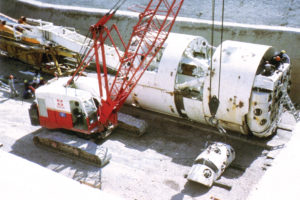 The Yindaruqin Irrigation Project is the largest self-flowing irrigation control system in China. The project is made up of 33 tunnels that are 75 km (46.6 mi) in length and divert water from the Datong River to dry regions of China’s northern Gansu Province.
The Yindaruqin Irrigation Project is the largest self-flowing irrigation control system in China. The project is made up of 33 tunnels that are 75 km (46.6 mi) in length and divert water from the Datong River to dry regions of China’s northern Gansu Province.
In 1990 the Gansu Province Resources Bureau awarded the contract for the project to Cooperative Muratori and Cementisti (CMC) of Ravenna, Italy. CMC chose a 5.5 m (18.0 ft) diameter Robbins Double Shield TBM for the first two drives of the multi-tunnel project.
Geology
Rock formations along the first tunnel, 30A, consist mostly of tertiary sediments and gently dipping conglomerate with drift block and sandy conglomerate. Precambrian crystalline limestone with slate occurs at the tunnel inlet and Quaternary sediments make up the outlet area. Other geologic features of the 30A site include 23 main faults in the limestone section and large karst caves.
The second tunnel, 38, passes through moderately dipping beds of Cretaceous sedimentary rocks, mostly sandstone.
TBM
Robbins built the Double Shield TBM with 37 back-loading 17 inch (432 mm) diameter disc cutters. Six electric motors generated 960 kW (1,287 hp) of power and supplied 3,065 kNm (2,368,000 lb-ft) of torque.
The TBM design included a telescoping section with 12 thrust cylinders behind the cutterhead. These cylinders provided roll control without the need for additional torque cylinders because they were installed at alternating angles between the gripper and forward shield. The arrangement allowed efficient vertical and lateral steering of the cutterhead and forward shield.
The TBM’s rear section housed the grippers and eight auxiliary thrust cylinders. Additional features of the TBM included a two-speed drive, a laser guidance system, hydraulic clutches, stand-by hydraulic pumps and oil filters.
Air compressors on the TBM’s 150 m (492 ft) long back-up train eliminated the need for an air line along the length of the excavation. A 1400 mm (55 in) diameter ventilation duct provided fresh air to the work area and an air scrubber extracts dust from the tunnel.
The back-up system included a single-track trailing gantry followed by a movable California switch. Additional fixed crossings occured at intervals of about 3,500 m (11,483 ft), depending on the average speed of empty and loaded muck cars.
The Robbins Double Shield TBM design allowed the tunnel lining to be installed simultaneously with excavation. The tunnel lining consisted of reinforced concrete segments mechanically erected from within the tail shield as the machine advanced. Each ring’s four segments fit together in a self-locking design, with the rounded lip of one curved segment overlapping that of the neighboring segments. A honeycomb pattern in the finished tunnel lining resulted from the staggered arrangement of segments within the rings. Each 300 mm (11.8 in) hexagonal segment was 1.6 m (5.2 ft) wide, a size that minimized the required number of rings. This feature contributed substantially to the superior advance rate of the TBM.
Tunnel Excavation
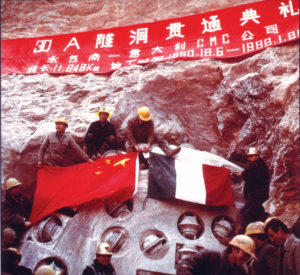 The TBM exhibited impressive advance rates — even breaking the world record for average monthly production for TBMs 5 to 6 m (16.4 to 19.7 ft) in diameter. The TBM began boring the 11.7 km (7.3 mi) tunnel 30A on January 9, 1991. The machine bored 780 m (2,559 ft) in the first 22 days and finished five months ahead of schedule. Its average daily advance was 36.09 m (118.4 ft), and its average penetration rate was 4.99 m (16.4 ft) per hour. July 1991 was the machine’s best working month with a total advance of 1,301 m (4,268 ft).
The TBM exhibited impressive advance rates — even breaking the world record for average monthly production for TBMs 5 to 6 m (16.4 to 19.7 ft) in diameter. The TBM began boring the 11.7 km (7.3 mi) tunnel 30A on January 9, 1991. The machine bored 780 m (2,559 ft) in the first 22 days and finished five months ahead of schedule. Its average daily advance was 36.09 m (118.4 ft), and its average penetration rate was 4.99 m (16.4 ft) per hour. July 1991 was the machine’s best working month with a total advance of 1,301 m (4,268 ft).
The success of the TBM is remarkable considering the troublesome geology of the tunnel. About 2,300 m (7,545 ft) into the drive, sticky argillaceous conglomerate caused clogging of the muck buckets, chute, hopper and cutter housings. Also, the machine encountered 60 to 150 liter (15.9 to 39.6 gallon) per second water inrushes in fractured calcareous rock around 9,000 m (29,527 ft) into the tunnel. The TBM advance slowed through this section but quickly recovered for the rest of the excavation.
On January 20, 1992, the machine holed through the first tunnel. Work on the second 4.9 km (3.0 mi) tunnel began in April 1992 and finished in August of the same year. In June 1992, the TBM set a world record for 5-6 m (16.4 ft – 19.6 ft) diameter class TBMs when it excavated 1,401.6 m (4,598.4 ft) in one month. Its average daily advance was 40.67 m (133.4 ft), with a maximum of 75.2 m (246.7 ft) on May 11. The TBM’s overall rate of advance was 4.01 m (13.2 ft) per hour.
The machine completed its second tunnel in 120 working days. The original bid specifications for Yindaruqin’s first two tunnels included a 54-month excavation time limit. Both projects were completed in 20 months, less than half the allotted time.
The Yellow River Water Diversion Project
Project Overview
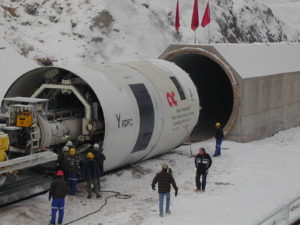
The Yellow River Water Diversion Project is an ambitious network of tunnels that brings water to chronically dry areas of Shanxi Province. The water system consists of multiple tunnels totaling over 100 km (62 mi) in length.
The Joint Venture (CMC, Impregilo, Chinese Water Conservancy and Hydropower Engineering Bureau No. 4) was awarded Lots 2 and 3 in 1997. Cooperativa Muratori Cementisti Ravenna (CMC) of Italy was awarded the contract for Lot 5 in 2000. All of the contractors chose Robbins Double Shield TBMs to bore through the challenging geology.
Geology
Lot 2: The geology in Lot 2 consisted of limestone and dolomitic rock characterized by occasional faults. Karst formations were also abundant. The Unconfined Compressive Strength (UCS) of the rock was 39 – 137 MPa (6 – 20 ksi).
Lot 3: Lot 3 geology was made up of dipping and folded dolomitic limestone and Triassic sandstone and mudstone with a UCS the same as that of Lot 2. The rock is dominated by abundant high-angled faults with occasional karst formations.
Lot 5: Lot 5 consisted of limestone, sandstone, and siltstone with occasional faults and an UCS of 25 – 206 Mpa (4 – 30 ksi).
TBMs
Lot 2: Lot 2 used two Robbins Double Shield TBMs. The first machine was a new Robbins TBM that excavated two tunnels (Tunnels T4 and T5) of 6.6 km (4.1 mi) and 25.5 km (15.8 mi) in length. The TBM featured a 4.92 m (16.1 ft) diameter cutterhead and 17 inch (432 mm) cutters. The TBM was equipped with a variable frequency drive (VFD) and supplied 1,575 kW (2,112 hp) to the cutterhead. The machine could generate a cutterhead thrust of 9,074 kN (2,040,000 lb) and create a torque of 2,159,424 N-m (1,591,300 lb-ft).
For the second machine on Lot 2, Robbins also refurbished a 4.9 m diameter (16.1 ft) TBM for a 14 km (8.7 mi) long tunnel (Tunnel T6). This TBM featured 17 inch (432 mm) cutters with six 75/210 kW motors and a total installed power of 3,000 kW.
Both TBMs used identical back-up systems. Each 300 m (984 ft) long back-up system used a mucking-out train with ballasted muck cars and a pair of rail sidings to form an onboard California switch. Water services, the ventilation cassette and cable reels were near the rear of the back-up.
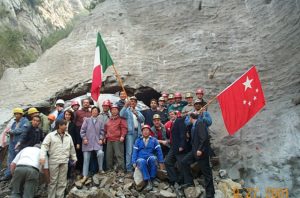 Lot 3: Another Double Shield TBM was used for a 22 km (13.7 mi) long section of tunnel T7 in Lot 3. The 4.8 m (15.7 ft) diameter Robbins Double Shield TBM featured 17 inch (432 mm) cutters and could generate a cutterhead thrust of 9,074 kN (2,040,000lb). The machine could also generate a torque of 2,159,424 N-m (1,591,300 lb-ft). A TBM made by NFM bored the other half of the 40.7 km long T7 tunnel.
Lot 3: Another Double Shield TBM was used for a 22 km (13.7 mi) long section of tunnel T7 in Lot 3. The 4.8 m (15.7 ft) diameter Robbins Double Shield TBM featured 17 inch (432 mm) cutters and could generate a cutterhead thrust of 9,074 kN (2,040,000lb). The machine could also generate a torque of 2,159,424 N-m (1,591,300 lb-ft). A TBM made by NFM bored the other half of the 40.7 km long T7 tunnel.
The back-up system for this TBM was identical to those in Lot 2.
Lot 5: For Lot 5, CMC utilized a 4.8 m (15.7 ft) diameter Robbins TBM that had been stored in China since 1994. The machine was completely refurbished by Robbins for the project. CMC and Robbins agreed to reinforce the existing cutterhead for improved reliability in fractured geology. The machine was also fitted with a tail shield and wire brush seals to protect against water inflows. The machine featured 17 inch (432 mm) cutters and it could generate a cutterhead thrust of 7,562 kN (1,700,013 lb). The torque at the cutterhead reached up to 1,936,568 N-m (1,438,000 lb-ft).
The back-up system for the Lot 5 TBM was custom built for increased performance. Robbins extended the back-up to provide for a train length on deck with sufficient muck carrying and materials delivery capacity for two TBM strokes. The segment handling system was modified as well for more rapid handling of tunnel lining segments.
Tunnel Excavation
Excavation began simultaneously on Lots 2 and 3 in February 1999. The T4 TBM bored the 6.6 km (4.1 mi) tunnel in just eight months and experienced relatively few problems. The machine broke a world record in its size class with a best month of 1,822 m (5,978 ft) and achieved a best day of 99.4 m (326 ft). The same TBM bored the 25.5 km (15.8 mi) long T5 tunnel beginning in November 1999 and ending in 2001 with few problems.
The refurbished Robbins TBM started boring the 14 km (8.7 mi) long T6 tunnel in December 1999. The TBM encountered long sections of clay and a 6 m (19.7 ft) wide karst cavity that had to be filled with pea gravel and reinforced concrete to let the machine pass. Despite the challenges, the TBM achieved advance rates of 81.0 m (266 ft), a best month of 1,375 m (4,511 ft), and an average monthly advance rate of 550 m (1,804 ft).
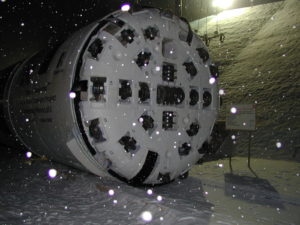
Boring the 22 km (13.7 mi) section of Tunnel T7 at Lot 3 began in February 1999 and ended in April 2001. The Robbins TBM and the NFM machine began at opposite ends of the tunnel and met in the middle. The Robbins machine encountered a 50/50 limestone/sandstone mixture of abrasive rock and several high-angled fault lines. However, it still managed to achieve an average month of over 700 m (2,297 ft) and had a best month of 1,281 m (4,203 ft).
Lot 5 excavation began as boring at Lots 2 and 3 was finishing up in September 2000. By December 8th, the refurbished Robbins TBM had already set a best day of 36.1 m (118 ft) and averaged over 1,000 m (3,281 ft) in its first month. The machine later set a world record for its size class at 1,352 m (4,436 ft) per month. The TBM holed through the 13.5 km (8.4 mi) long tunnel in September 2001.
South Mountain
Project Overview
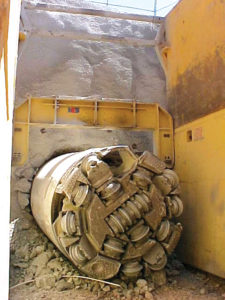 Arizona’s South Mountain water tunnel is part of a 27.3 km (17 mi) water pipeline that delivers 178 million liters (47 million gallons) of water a day to the city of Phoenix. The pipeline serves the Ahwatukee Foothills area, which has experienced 145% population growth in the last decade.
Arizona’s South Mountain water tunnel is part of a 27.3 km (17 mi) water pipeline that delivers 178 million liters (47 million gallons) of water a day to the city of Phoenix. The pipeline serves the Ahwatukee Foothills area, which has experienced 145% population growth in the last decade.
In 2000, the City of Phoenix awarded the $11 million USD construction contract to Affholder Inc. Affholder chose a refurbished Robbins Double Shield TBM adapted for the variable rock conditions in the tunnel.
Geology
The tunnel passes through three types of rock. The first and last sections of tunnel consist of the hard, coarse-grained rocks granite and gneiss. The middle of the tunnel consists of two infiltrations of alluvial soils. This soil is mixed grain and exhibits secondary calcification. Locally known as caliche, these soils can exhibit behavior similar to rock.
To address the challenge of soil deposits, tunnel design consultants recommended steel ribs with lagging for tunnel support.
TBM
Robbins rebuilt the 2.4 m (7.9 ft) diameter Double Shield TBM for the variable rock conditions in the tunnel. The TBM design included dual propulsion systems, a protective shield, recessed cutters, and the ability to reverse cutterhead direction.
The TBM featured 432 mm (17 in) cutters and a maximum thrust of 4,372 kN (1,006,000 lb). The 60 Metric ton (66 US ton) machine was capable of generating 194,172 N-m (146,000 lb-ft) of torque.
Tunnel Excavation
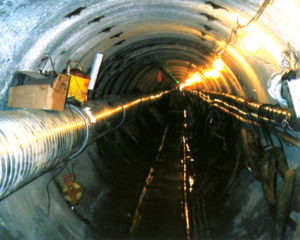 The TBM began boring the 1.85 km (1.15 mi) long tunnel in December 2000 and encountered its first soil deposits three months later. The soft soil prompted a switch from rock bolts to steel ribs and wood lagging for the tunnel lining. The machine reached the second infiltration of soil after boring through a 360 m (1,181 ft) section of gneiss. The TBM excavated the final sections of the tunnel with no problems and finished on schedule in August 2001.
The TBM began boring the 1.85 km (1.15 mi) long tunnel in December 2000 and encountered its first soil deposits three months later. The soft soil prompted a switch from rock bolts to steel ribs and wood lagging for the tunnel lining. The machine reached the second infiltration of soil after boring through a 360 m (1,181 ft) section of gneiss. The TBM excavated the final sections of the tunnel with no problems and finished on schedule in August 2001.
The crew worked in 9-hour shifts and the maximum rate of advance was 26 m (85.3 ft) in a single shift. The TBM average rate of advance was 1.5 m (4.9 ft) per hour.
Cleveland Sewer
Project Overview
The Cleveland Heights Interceptor Project is a sewer system improvement project located in the Heights/Hilltop area of Cleveland. The project is one of hundreds projects mandated by the USA Environmental Protection Agency in the wake of the Clean Water Act which required communities to improved the quality of America’s river and lake water. (For more information on the Clean Water Act and its effects, see www.epa.gov/r5water/cwa.htm).
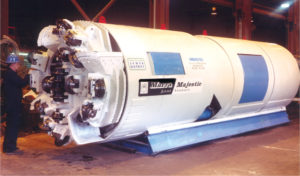 During the torrential rains of spring and summer in the Cleveland area, the water flow overcame the existing sewer system resulting in flooding and the discharge of untreated water into Lake Erie. Larger-diameter pipelines were proposed to help reduce the basement flooding and sewage overflow problems which were common in the crowded urban area.
During the torrential rains of spring and summer in the Cleveland area, the water flow overcame the existing sewer system resulting in flooding and the discharge of untreated water into Lake Erie. Larger-diameter pipelines were proposed to help reduce the basement flooding and sewage overflow problems which were common in the crowded urban area.
Geology
The TBM passed mostly through gray Berea sandstone that is fine to medium grained and significantly fractured in discrete zones. The rock has moderate to high abrasiveness as well as a potential for gas and water inflows from fissures and joints.
TBM
Robbins designed the 2.2 m (7.2 ft) diameter TBM to bore through fractured rock with potentials for water inflow. The TBM included a variable speed, hydraulic cutterhead drive and a high-capacity asymmetric main bearing. The machine also included roof and probe drills for rock support and pre-excavation ground investigations respectively. The TBM featured 12 inch (305 mm) cutters that could generate a maximum thrust of 4,472 kN (1,006,000 lb). Maximum cutterhead torque was 194,172 N-m (146,000 lb-ft). The 60-ton, gantry-style back-up system was designed to run efficiently with muck cars at maximum capacity.
Tunnel Excavation
The TBM began boring in July 1998. It experienced few problems and achieved impressive daily advance rates. Between the months of September and December 1998 the machine averaged 42 m (138 ft) per day and achieved a best day of 55 m (182 ft) bored. The machine finished in December 1998 with a monthly average of 442 m (1450 ft). Crews worked in 5-day work weeks with 2 shifts per day and the machine averaged 21 m (69 ft) per shift.
Pinglu Tunnel
Veteran Double Shield completes one of the World’s Longest Single-Drive Tunnels
Project Overview
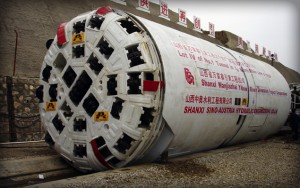 The Pinglu Tunnel, part of the Yellow River Water Diversion Project, was undertaken in 2006 by Joint Venture Sino-Austria Hydraulic Engineering Co. Ltd (SAHEC), led by Alpine Bau GmbH. At 24.5 km (15.8 mi), the Pinglu Tunnel marks one of the world’s longest single-drive TBM tunnels ever excavated. The entire scheme will transfer water from the Yellow River to dry regions of Shanxi Province, an area that receives just 400 mm (16 in) of rainfall per year on average.
The Pinglu Tunnel, part of the Yellow River Water Diversion Project, was undertaken in 2006 by Joint Venture Sino-Austria Hydraulic Engineering Co. Ltd (SAHEC), led by Alpine Bau GmbH. At 24.5 km (15.8 mi), the Pinglu Tunnel marks one of the world’s longest single-drive TBM tunnels ever excavated. The entire scheme will transfer water from the Yellow River to dry regions of Shanxi Province, an area that receives just 400 mm (16 in) of rainfall per year on average.
The completed Pinglu Tunnel will go into operation in October 2011, connecting the North Main Line of the Yellow River Project to transfer water to Pinglu, Shuozhou, and Datong areas. The South Main Line of the Yellow River Water Diversion Project was completed between 1999 and 2001, which encompassed over 100 km (62 mi) of tunnel excavated using five TBMs, four of which were Robbins Double Shield TBMs.
TBM Design
The Robbins Double Shield TBM excavating the Pinglu Tunnel was previously used on the record-breaking 12 km (7 mi) long segment of the Yellow River Diversion in 2000. During that project, the Double Shield set two world records in its size class of 4 to 5 m (13 to 16 ft): best month (1,855 m/6,085 ft) and monthly average (1,352 m/4,435 ft). Both records still stand.
Since the TBM was used on a prior tunnel for this project and designed for similar geology, only the back-up system was modified. Due to the length of the tunnel, the back-up frame was extended from one stroke to two strokes. This key change allowed the machine to maintain good advance rates despite 70 minute transit times for muck trains from the machine to the tunnel entrance.
Tunnel Excavation
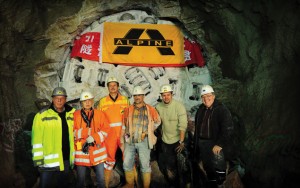 The machine began boring at the remote jobsite on September 30, 2006. Tunneling was a challenging process, as the geology consisted of 12 m (40 ft) thick coal seams and abrasive sandstone that required intensive monitoring of tunnel air for particulates. Up to 70% quartzite content made the rock very abrasive. This combination of 70% quartzite and 6% corundum made the rock seven times more abrasive than quartzite—equal to the material that grinding wheels are made of. This required rigorous maintenance of the cutterhead with a daily 4-hour shift, and replacement of the bucket lips.
The machine began boring at the remote jobsite on September 30, 2006. Tunneling was a challenging process, as the geology consisted of 12 m (40 ft) thick coal seams and abrasive sandstone that required intensive monitoring of tunnel air for particulates. Up to 70% quartzite content made the rock very abrasive. This combination of 70% quartzite and 6% corundum made the rock seven times more abrasive than quartzite—equal to the material that grinding wheels are made of. This required rigorous maintenance of the cutterhead with a daily 4-hour shift, and replacement of the bucket lips.
Muck removal was by trains of rota-dump muck cars in two tracks using California switches. The back-up system was equipped with floor chain movers to shunt the muck cars as they filled. Ventilation in the long tunnel was generated at a minimum rate of 5.4 m3/sec (190 ft3/sec) by high-powered fans. The fans, situated at the portal, deliver fresh air to the tunnel face via 1.4 m (4.6 ft) diameter flexible ducting.
Lining for the Pinglu Tunnel, which consisted of unique hexagonal segments, was produced near the jobsite by Alpine. A crew of nearly 400 people worked at the remote site and segment factory to cast the specialized structures. During excavation, the segments were placed longitudinally in a honeycomb configuration in rings of four elements which allowed high-speed, continuous boring with no downtime while erecting segments. Advance rates topped out at 50 ring sets, or about 70 m (230 ft), per day.
On November 13, 2010, Alpine celebrated the Robbins machine break through with a crowd of more than 500 including Austrian and Chinese guests of honor and the entire tunneling crew.
Sochi Complex 3
Robbins TBMs make New Connections for Olympic Games
Project Overview
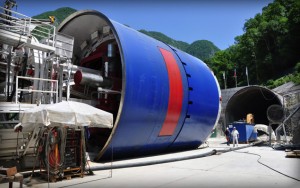 In 2012, the final of two Robbins Double Shield TBMs completed tunneling on schedule in Sochi, Russia in preparation for the host city’s 2014 Winter Olympic Games. In addition to the construction of the new Olympic park, water supply lines, power stations and arenas, the resort city wants to make sure that transportation isn’t a problem for its visitors. The transportation infrastructure project, commissioned by owner DCRC-Sochi, was divided into six complexes and will link road and railway routes between the small town of Adler on the Black Sea and the mountain resort of Alpika. The new lines will also connect to the M-27 highway, which travels along the Mzymta River through a national forest preserve with 46 bridges and 12 tunnels.
In 2012, the final of two Robbins Double Shield TBMs completed tunneling on schedule in Sochi, Russia in preparation for the host city’s 2014 Winter Olympic Games. In addition to the construction of the new Olympic park, water supply lines, power stations and arenas, the resort city wants to make sure that transportation isn’t a problem for its visitors. The transportation infrastructure project, commissioned by owner DCRC-Sochi, was divided into six complexes and will link road and railway routes between the small town of Adler on the Black Sea and the mountain resort of Alpika. The new lines will also connect to the M-27 highway, which travels along the Mzymta River through a national forest preserve with 46 bridges and 12 tunnels.
The entire project consists of 48.2 km (30 mi) of new road and railway lines, with a strict completion deadline of June 2013. In order to meet the schedule, excavation was performed in various ways, including using roadheaders, drill and blast equipment, and five TBMs.
Custom Rebuilds
Contractors OJSC Stroy-Trest and CSC Bamtunnelstroy ordered two refurbished TBMs to excavate parallel service and railway tunnels measuring 5.8 km (2.8 mi) and 4.6 km (2.9 mi), respectively. The rebuilt machines were selected to construct the tunnels due to their fast procurement time compared to new machines and the aggressive deadline of the project. A 10.0 m (32.8 ft) TBM was originally used on the Abdalajis rail tunnels in Spain between 2003 and 2006 and removed from storage for the Complex 3 tunnel. A 6.2 m (23.3 ft) Double Shield was originally built in 1993 for a hydroelectric project in Switzerland, and has since been used on multiple tunneling projects, totaling over 45 km (28 mi).
The 10.0 m (32.8 ft) machine was supplied for the Sochi project as rebuilt by a sub-contracted supplier, but several problems at start-up unveiled that some of the machine’s major components needed to be refurbished or replaced. After learning this, Bamtunnelstroy hired Robbins for on-site technical service and project consulting for Complex 3, as they were the original manufacturers of two of the three TBMs.
A crew of 15 from Robbins field service and engineering departments repaired and modified both TBMs. The 10.0 m (32.8 ft) machine received a new cutterhead support from Italy, while the main bearing was refurbished at a factory in Germany. In order to transport the 30 metric ton main bearing, the Antonov 124-100 aircraft was used, as it is the only one in existence that can carry these loads. The TBM also received upgrades to the lube system, cutterhead pressurization, and changes to the seal lubrication system. The 6.2 m (23.3 ft) Double Shield received new gear boxes and a PLC system. To make sure boring went smoothly, the Robbins crew stayed onsite until both machines were up and running.
Geology
The Robbins TBMs were specifically designed to excavate the fractured and faulted sedimentary geology that makes up the Sochi region. After testing the soil, it was determined that the machines would be boring mostly massive to completely fractured limestone with clay seams. Some sedimentary rock with sandstone and siltstone was also detected, as were fault zones made up of breccias and conglomerates.
Both machines were designed with a flat face, low profile muck buckets and radial scoops to optimize stabilization at the face of the tunnel. They were also equipped with replaceable bucket lips and injection ports, which allow foam additives to be injected into the soil through the cutterhead to treat the ground before and during boring.
Tunnel Excavation
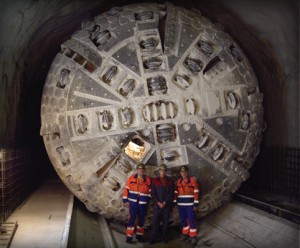 The 6.2 m (23.3 ft) TBM was launched in March 2010 in mixed ground. In May, however, the machine was stopped after it came across a fault zone consisting of broken rock and running soft ground. Field service crews were able to free the machine by hand excavating a timber bypass structure around the machine in front of the cutterhead, allowing debris to be removed. To evaluate the ground ahead, the crew drilled up to 62 m (203.4 ft) in front of the machine and found that the geology consisted of highly fractured ground. In order to accommodate the ground, polymer foam was injected in front of the machine to consolidate porphyry material around and in front of the cutterhead. The TBM was able to move forward without a problem once this was completed. To prevent a recurrence of the problem, crews performed continuous probe drilling during the remainder of the advance. When necessary, the ground was treated with cement silicate and foam to keep the machine moving steadily forward.
The 6.2 m (23.3 ft) TBM was launched in March 2010 in mixed ground. In May, however, the machine was stopped after it came across a fault zone consisting of broken rock and running soft ground. Field service crews were able to free the machine by hand excavating a timber bypass structure around the machine in front of the cutterhead, allowing debris to be removed. To evaluate the ground ahead, the crew drilled up to 62 m (203.4 ft) in front of the machine and found that the geology consisted of highly fractured ground. In order to accommodate the ground, polymer foam was injected in front of the machine to consolidate porphyry material around and in front of the cutterhead. The TBM was able to move forward without a problem once this was completed. To prevent a recurrence of the problem, crews performed continuous probe drilling during the remainder of the advance. When necessary, the ground was treated with cement silicate and foam to keep the machine moving steadily forward.
Despite its challenges, the 6.2 m (23.3 ft) TBM experienced good advance rates of 100 to 120 m (328.1 ft to 393.7 ft) per week, and 14 m (46 ft) per day. The machine achieved breakthrough at the service tunnel on March 2, 2011. After completion, the machine was disassembled and is now being stored near the city of Novorossiysk. It is expected to be used for future tunneling projects, as it is in good shape and experienced very low cutter wear during its bore on Complex 3.
The 10.0 m (32.8 ft) Double Shield was launched in September 2010 and excavated effectively through fault zones 25 and 50 m (82.0 and 164.0 ft) wide, consisting of highly weathered material have been excavated so far, using probe drilling and pre-grouting to consolidate the rock. The massive machine completed its excavation in 2012, breaking through on February 14.
Recent Posts
- Twin Robbins EPBs make milestones near Taj Mahal
- Long Haul TBM: Use of a Rebuilt Main Beam Machine at the DigIndy Tunnel System in Indianapolis, IN
- Evaluating TBM Design and Performance, 30 Years Apart: The Lesotho Highlands Water Tunnel, Phase 1 and Phase 2
- Overcoming Mountainous Geology at Nepal's Sunkoshi Marin Project
- Swift Robbins TBM breaks through 11 Months Early

 Close
Close  Menu
Menu 